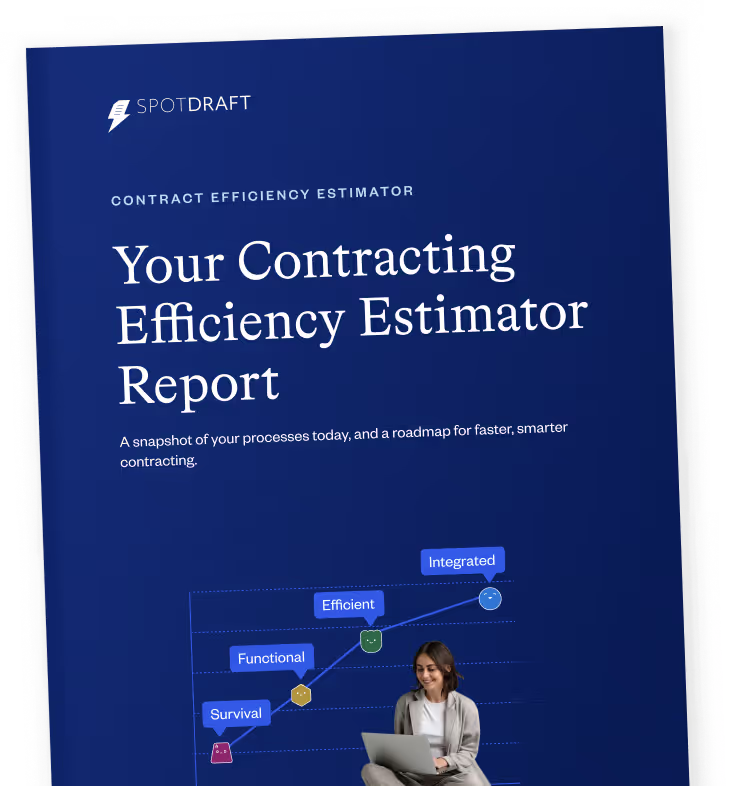Key Takeaways
· Tracking the right contract management KPIs helps improve contract efficiency and showcase the legal team’s value.
· Focus on critical metrics like contract cycle time, deal value, and risk analysis rather than tracking too many indicators.
· Use automated KPI dashboards to get real-time visibility into performance, SLA adherence, and obligation management.
· Regular KPI reviews over time help measure continuous improvement and maintain business alignment between legal and business functions.
· Investing in tools like SpotDraft CLM accelerates contract efficacy through centralized reporting, data visualization, and smart automation.
Contract management KPIs empower legal teams to see past the obvious and get real insights into the effectiveness of their processes.
However, with so many metrics to track, it’s easy to get lost in the numbers. While some KPIs might seem important at first glance, only a select few have a true impact on your organization’s overarching objective.
In this guide, we’ll discuss four crucial metrics that are worth analyzing alongside best practices you can incorporate to get the best out of contract management KPIs.
What are contract management KPIs?
Contract management KPIs (short for Key Performance Indicators) are metrics used to track the effectiveness of contract management processes. These metrics cover the entire contract lifecycle, from creation to expiration or renewal.
Monitoring them allows you to identify areas for improvement and align contract management operations with broader business goals such as revenue growth, compliance, and risk management.
Also read: How Contract Analytics Improves Legal Performance

Source: Efemini F-Awosika via LinkedIn
How do contract management KPIs set the legal team up for success?
“For example, my average for marketing review is around 1.8 days. Whenever someone's worried about the process and says something like, ‘Do I have to submit all marketing to Legal?’ — I try to stress the partnership again. Here’s why I need to review everything, here’s my experience in why that matters when you want to go public or get acquired, and here’s what standards I’m willing to hold myself to so that you don’t have to worry about turnaround times. More often than not, they’re not upset that you need to be involved. They probably just worry it will be slow, or you’ll have non-legal feedback disguised as legal. So don't be scared of the process, be scared of a flawed process.”
— Ryan Nier, General Counsel, Pinwheel
There is often friction between legal and business teams. Modern legal teams must look at things more holistically to understand why this gap exists.
Often, the answer lies within the contracting process itself. It boils down to the following:
- How easy is it for business teams to communicate their requirements with legal?
- Is the legal turnaround time too long?
- Is there a misalignment between legal and business priorities?
- Are there tools (like contract management software) that business teams don’t use or are unaware of, leading to inefficiencies?
Setting KPIs helps answer these questions by turning them into quantifiable problems.

Source: Roy E. Henry Jr via LinkedIn
Let’s say the average legal turnaround time is 3 days; what can be done to reduce that? Which types of contracts can be templatized to minimize legal intervention?
The first step to eliminating these challenges is to make the contract management process more data driven. By examining available data, you can identify core issues and bridge the gap between legal and business.
“Try to glean as much info about what causes friction as possible. Your biggest wins will come from addressing these knowledge gaps or hesitancies that are blocking/slowing deals.”
~ Sue So, Head of Legal, Hopin
Streamlining Contracts in Hyper growth Startups
How to evaluate contract management KPIs
Contract management KPIs can be tricky sometimes. Yes, there are dozens of KPIs that you can look at. But to get real, actionable insights, you must evaluate them within the context of your overarching business goals.
#1 Narrow down to KPIs relevant to you
“The biggest mistake most legal departments make, in my opinion, is trying to track too many KPIs.”
~ Sterling Miller, CEO and Senior Counsel for Hilgers Graben PLLC
KPIs All In-House Legal Departments Should Track
Zoom in on KPIs that have the biggest impact on your organization’s objectives.
For instance, if your goal is to boost revenue, you should be focusing on metrics like total contracts closed, contract renewal rates, and average contract value.
#2 Focus on quality, not just quantity
It’s easy to get caught up in chasing high numbers, but more contracts don’t always mean better results. Metrics like average contract value (ACV) or contract fulfillment rate can reveal whether your contracts are driving meaningful outcomes or just filling up the books.
After all, it’s better to have ten high-performing contracts than twenty mediocre ones draining resources.
#3 Evaluate over extended periods
Effective KPI evaluation requires analyzing metrics over extended periods to spot meaningful trends. Tracking metrics over short bursts might show patterns that don’t reflect the bigger picture.
For instance, a sudden dip in contract renewals over one quarter might seem alarming. But if, over the past year, renewal rates are trending upwards, the quarterly blip could be a seasonal anomaly, not a systemic problem.
Also Read: Rethinking OKRs, KPIs, and Goals for In-House Legal Teams
The top four contract management KPIs
“Most C-suite executives bank on data and hard metrics and not word-of-mouth. When you have certain metrics that shed light on how legal teams have contributed to growing the revenue stream of the company, it becomes easier for the GC to make business cases.”
~ Gitanjali Pinto Faleiro, General Counsel, Company Secretary & CCO at Greenhill & Co.
The Counsel Corner: Navigating the C-Suite As a GC
When you first start tracking key performance indicators for your contract management process, it’s easy to feel overwhelmed due to the sheer amount of data available. However, you don’t have to start tracking everything immediately.
We spoke to legal leaders to understand some of the most critical metrics and have outlined the four most recommended KPIs below.
Webinar: KPIs Every Legal Team Should Be Tracking
#1 Number of deals/contracts closed

Number of contracts closed is, perhaps, one of the first things you should track, especially if you don’t know where to start.
Tracking this metric will help you understand:
- How many contracts did legal close throughout the year?
- What were the most and least productive months in terms of volume?
- What blockers impacted your team’s ability to close more contracts?
- What types of contracts were closed month-on-month, and how many of each were closed?
- Out of the contracts closed, how many had been templatized, and how many were created from scratch?
- Is there scope for further templatization to improve contract closure?
- What is the relation between the number of contracts closed versus the quality of contracts?
#2 Value of deals/contracts closed

Contract value is a crucial KPI for all contract-facing departments. Finance teams use this information to make forecasts, sales and procurement teams use this to understand the nature of the deals they’re closing and their average deal values, and so on.
For legal teams, tracking contract values helps identify:
- How the legal team’s productivity impacts revenue.
- Maximum, minimum, and average contract value.
- The relationship between contract value and contract term, contract renewals, etc.
- High-value contracts and deals they should dedicate more efforts to.
Also Read: 5 Key Contract Reports to Share for C-level Review
#3 Contract turnaround times (TAT)

“One of the revenue leaders I worked with told me, ‘Time kills all deals; you gotta close deals fast,’ and I keep this in mind every time I’m pulled into a sales deal.”
— Sue So, Head of Legal, Hopin
Contract turnaround time refers to the time it takes to completely process a contract from the initial drafting stage to its execution.
Tracking TAT helps legal teams understand:
- What was the overall cycle time for closing different types of contracts?
- What was the average TAT for each stage of the contract lifecycle?
- What are the types of contracts that take longer to close, and which are closed quickly?
- What is the difference in TAT for templatized vs editable contracts?
- What were the average and individual TATs for different legal team members?
“Contrary to what business teams might think, legal teams are usually not the ones delaying contract management processes. Most times, they are waiting on other teams and stakeholders for review, inputs, or approvals on certain aspects of the contract. It is critical to track these wait times and exclude them to showcase the actual TAT of the legal team. Setting up a process to reduce these wait times will also help Legal reduce contract closure cycle times.”
— Diwyata Burbure, Senior Vice President – Legal Tech @SpotDraft
#4 Contract risk and deviation analysis

It’s important to measure contract risks and deviations for effective contract management. Contract management lifecycle KPIs that legal teams can track for this include:
- Standard clause variance and deviations
- Contracts without renewal dates that are expiring soon
- Missed contractual obligations and compliance issues
- Missed or delayed approvals and signatures
- Disputes and complaint resolutions, etc.
Also Read: Effective Contract Risk Management: Top Tips & Strategies
How to track contract management KPIs as a legal function

Now that we’ve established why it’s important to track the efficiency of your contract management process and some key performance indicators you should consider, it’s time to outline how.
There are three ways you can track contract management KPIs:
#1 Tracking data manually through spreadsheets
A spreadsheet is the simplest and cheapest way to start tracking contract KPIs.
However, However, this method often fails to capture deeper insights into contract cycle time or contract efficacy, since manual data collection lacks consistency and timeliness.
Click here to Download: SpotDraft’s Contract Tracking and Management Spreadsheet Template.
#2 Automating reporting through your contract management software
If you use Contract Lifecycle Management software (CLM) software like SpotDraft, you can access intuitive KPI dashboards to evaluate contract efficiency, monitor SLA compliance, and analyze obligation management performance in one place. These tools automatically calculate cycle times, deviations, and performance trends for smarter decision-making.
“The best thing about SpotDraft is the report generation, which saves us from a lot of manual effort.”
— G2 Reviewer
These tools can automatically collect and analyze data, pulling up the reports you need without making you do a lot of manual work.
#3 Using dashboards to track and visualize data
Dashboards help visualize the data that drives business alignment. You can track contract cycle time, renewal rates, and deviation metrics to understand where your contracting process slows down. This data-driven visibility ensures your legal team remains aligned with broader business outcomes.
But before you buy a separate dashboard tool, check if your Contract Lifecycle Management software already offers dashboards with relevant metrics. Generally, it might be wiser to invest in a CLM instead.
Also read: 8 Top Contract Management Software Platforms
#4 Strengthening KPI tracking through automation and review
To truly improve contract efficiency and contract efficacy, legal teams must go beyond static reporting. Modern KPI dashboards enable real-time visibility into how contracts are performing, helping identify bottlenecks, delays, and risks early.
For example, tracking contract cycle time across different departments reveals where deals slow down, allowing you to take targeted actions that improve business alignment and service-level compliance (SLA).
Additionally, setting up regular KPI reviews over time helps you measure the evolution of your legal team’s performance. These periodic reviews ensure continuous improvement and outcome alignment across legal and business functions.
To make this process effective, combine automation tools like SpotDraft’s analytics console with structured obligation management processes. This ensures every commitment, from renewals to deliverables, is tracked and completed on time, minimizing risk exposure and enhancing contract efficacy across the organization.
What are the challenges in tracking contract management KPIs

Source:Jason Burgess via LinkedIn
1. Incomplete data source
Companies often have data spread across multiple systems, making pulling reports an uphill task. A recent report suggests companies have contract data scattered across 24 different systems.
Solution:
Use a CLM to centralize your entire contract portfolio. Leading contract management software like SpotDraft also integrates with all your favorite tools to create a single source of data you can use to pull out reports.

2. Poor standardization
A lack of standardization in contracts makes it tough to monitor KPIs. Different terminologies across contracts can create challenges in pulling data. For instance, if you are referring to a third-party consultant as a 'contractor' in some agreements and a 'service provider' in others, it becomes difficult to establish contract performance metrics for tracking the counterparty’s contractual obligations.
Solution:
You can create standardized templates for different business cases. SpotDraft makes it easy to create custom templates that are best suited for your organization.
3. Technology limitations
Not having a quick and easy way to measure KPIs makes the process more cumbersome. If your current process involves many steps, then you won't do it as frequently.
Solution:
Use contract solutions like SpotDraft with an inbuilt contract reporting console providing a quick summary of all important KPIs. It will make it easy for your teams to track KPIs and consistently improve contract management.
The importance of continuous KPI evolution
KPI tracking is not a one-time activity, it’s an ongoing process. Over time, your organization’s priorities will shift, and so must your metrics. Regular KPI reviews over time help ensure that your contract efficiency goals evolve in line with business needs.
For instance, as your organization grows, your focus might move from improving contract cycle time to optimizing contract efficacy and minimizing post-signature risks through effective obligation management. Maintaining flexible KPI dashboards ensures your team can adapt to these changing goals and maintain strong business alignment.
Make your insights count
It’s difficult to quantify the value of all the work legal teams do, as many of the tasks, such as advising leadership teams, managing contract risk, etc., are strategic and complex in nature.
However, many parts of the contract management process can (and should) be quantified into clear, actionable KPIs that not only demonstrate the legal team’s value but also set them up for success.
SpotDraft CLM has helped hundreds of organizations unlock priceless insights through its powerful contract analytics and reporting solutions.
Want to see how it can change the game for your organization? Book a demo with our experts now.

.avif)
.avif)







